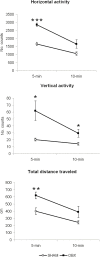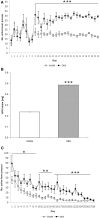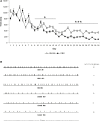Enhanced self-administration of the CB1 receptor agonist WIN55,212-2 in olfactory bulbectomized rats: evaluation of possible serotonergic and dopaminergic underlying mechanisms
- PMID: 24688470
- PMCID: PMC3960502
- DOI: 10.3389/fphar.2014.00044
Enhanced self-administration of the CB1 receptor agonist WIN55,212-2 in olfactory bulbectomized rats: evaluation of possible serotonergic and dopaminergic underlying mechanisms
Abstract
Depression has been associated with drug consumption, including heavy or problematic cannabis use. According to an animal model of depression and substance use disorder comorbidity, we combined the olfactory bulbectomy (OBX) model of depression with intravenous drug self-administration procedure to verify whether depressive-like rats displayed altered voluntary intake of the CB1 receptor agonist WIN55,212-2 (WIN, 12.5 μg/kg/infusion). To this aim, olfactory-bulbectomized (OBX) and sham-operated (SHAM) Lister Hooded rats were allowed to self-administer WIN by lever-pressing under a continuous [fixed ratio 1 (FR-1)] schedule of reinforcement in 2 h daily sessions. Data showed that both OBX and SHAM rats developed stable WIN intake; yet, responses in OBX were constantly higher than in SHAM rats soon after the first week of training. In addition, OBX rats took significantly longer to extinguish the drug-seeking behavior after vehicle substitution. Acute pre-treatment with serotonin 5HT1B receptor agonist, CGS-12066B (2.5-10 mg/kg), did not significantly modify WIN intake in OBX and SHAM Lister Hooded rats. Furthermore, acute pre-treatment with CGS-12066B (10 and 15 mg/kg) did not alter responses in parallel groups of OBX and SHAM Sprague Dawley rats self-administering methamphetamine under higher (FR-2) reinforcement schedule with nose-poking as operandum. Finally, dopamine levels in the nucleus accumbens (NAc) of OBX rats did not increase in response to a WIN challenge, as in SHAM rats, indicating a dopaminergic dysfunction in bulbectomized rats. Altogether, our findings suggest that a depressive-like state may alter cannabinoid CB1 receptor agonist-induced brain reward function and that a dopaminergic rather than a 5-HT1B mechanism is likely to underlie enhanced WIN self-administration in OBX rats.
Keywords: WIN55212-2; cannabinoid; depression; dopamine; drug dependence; methamphetamine; olfactory bulbectomy; serotonin.
Figures







References
LinkOut - more resources
Full Text Sources
Other Literature Sources
Miscellaneous

